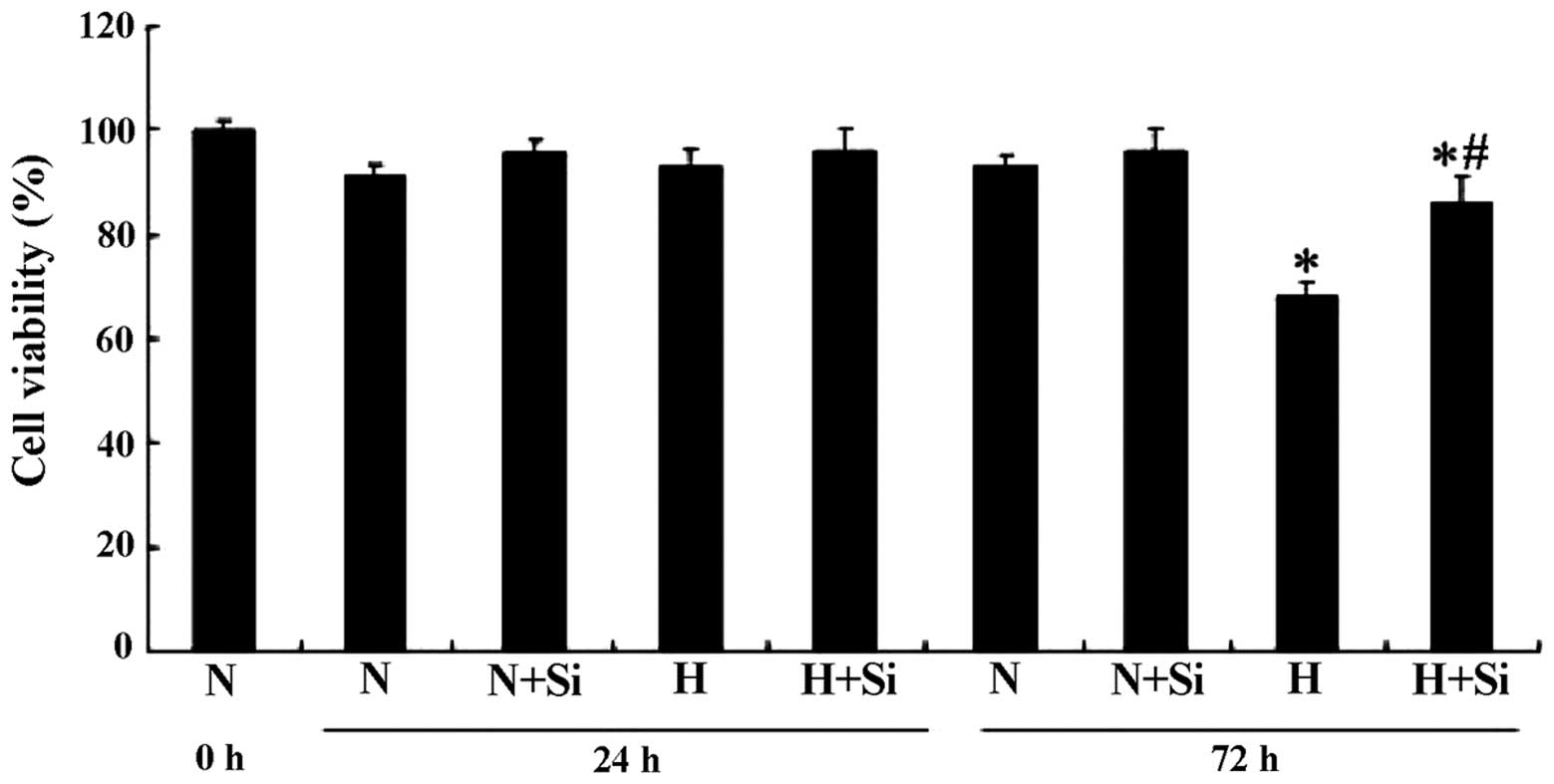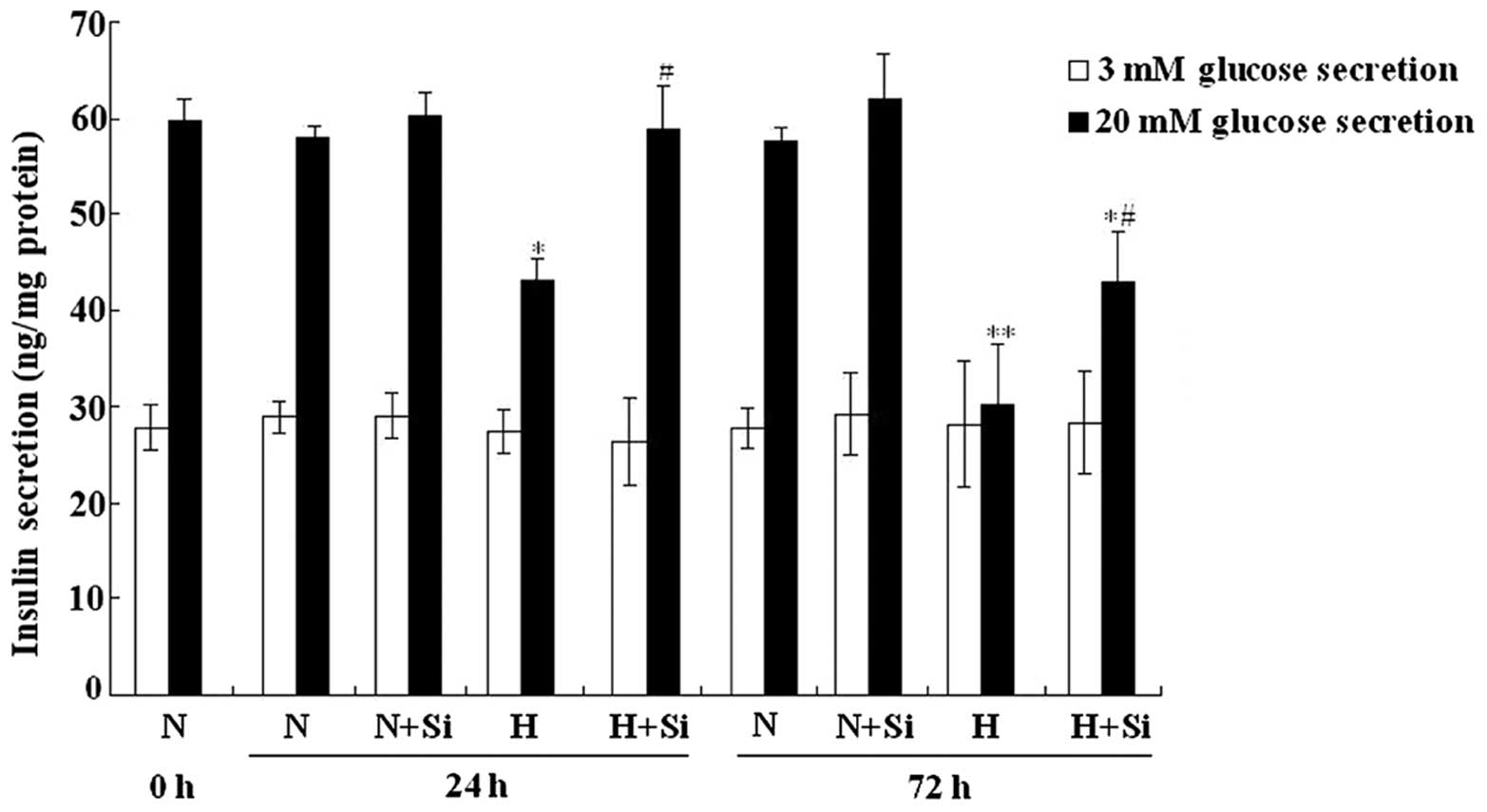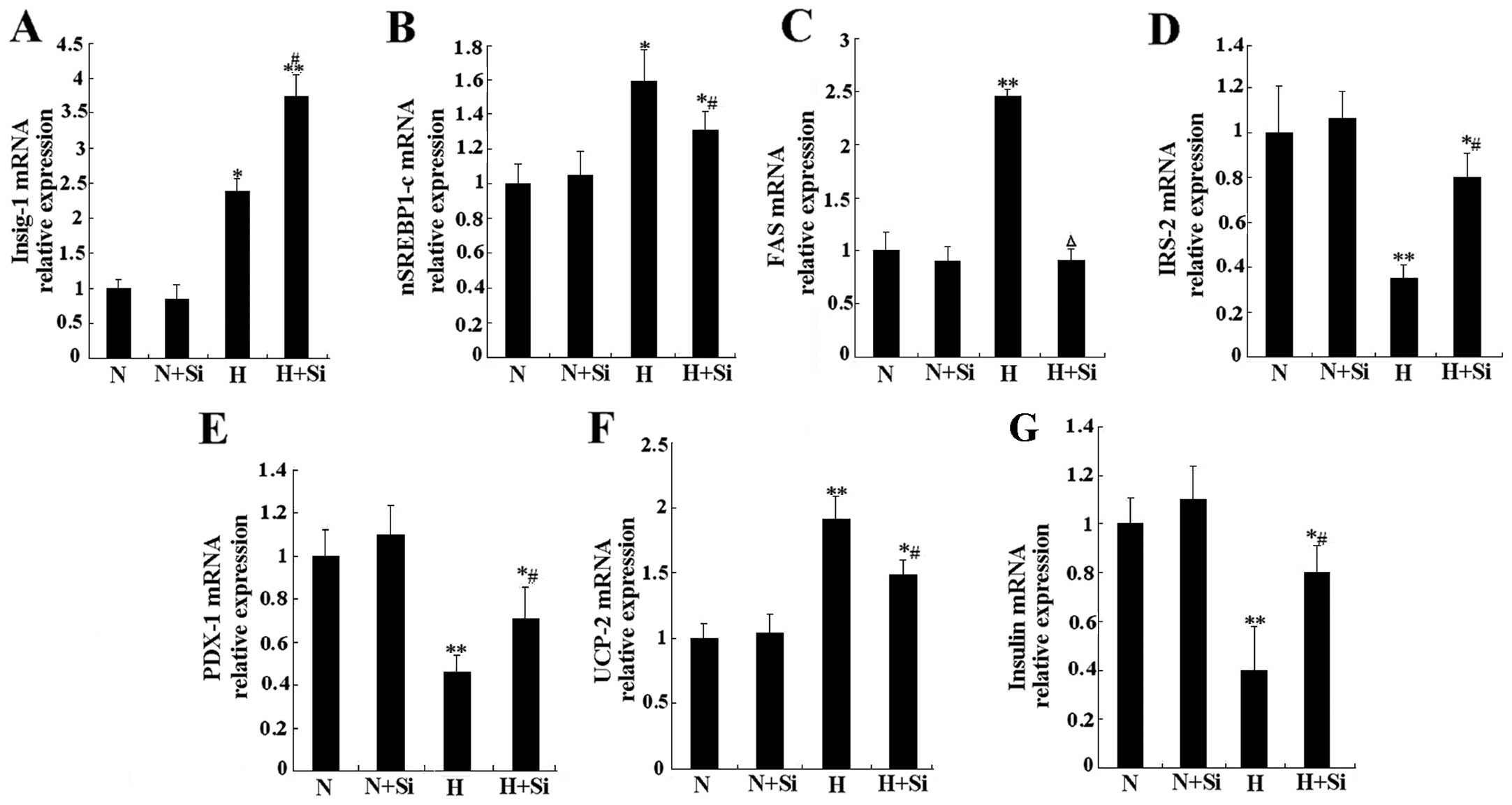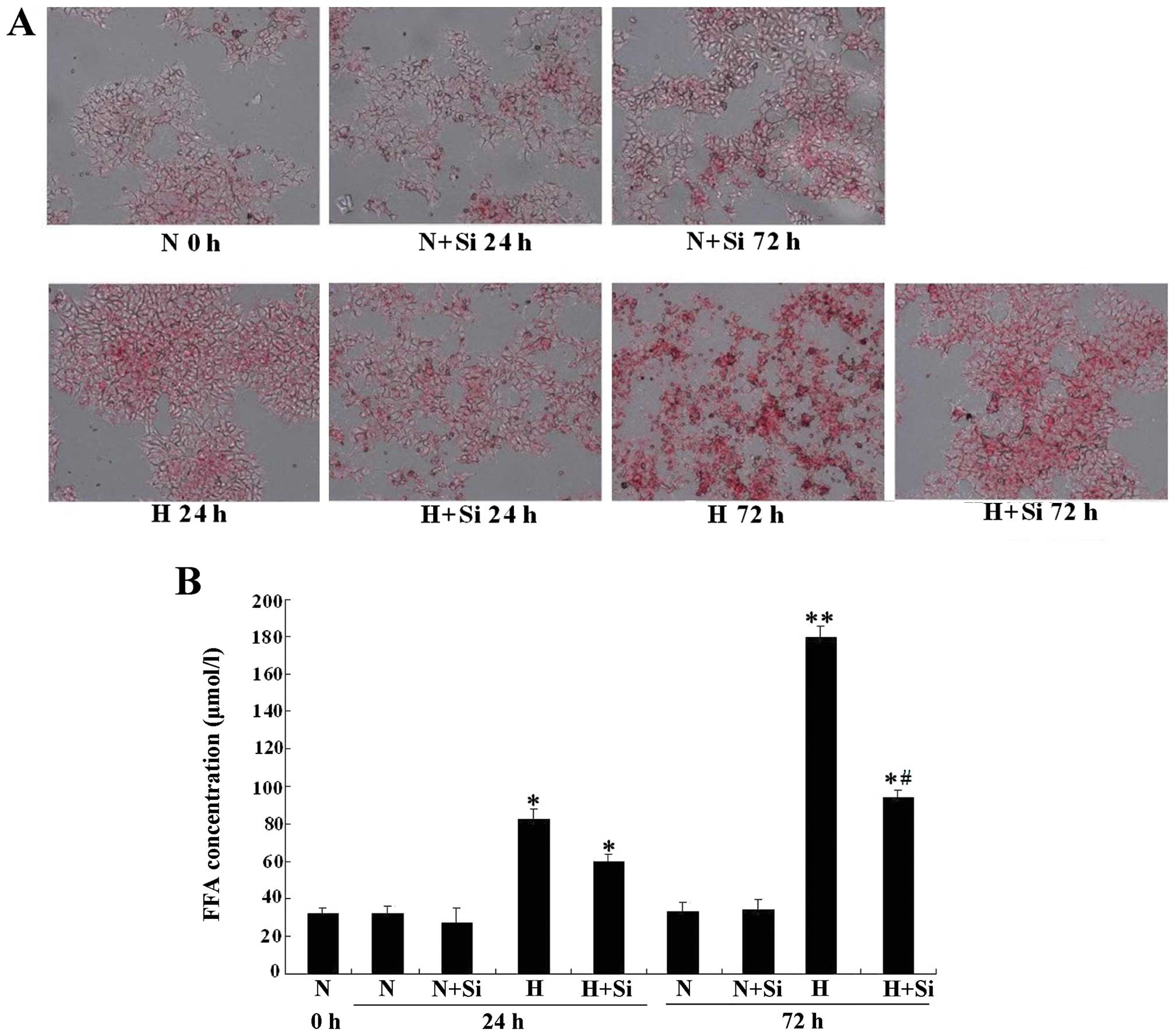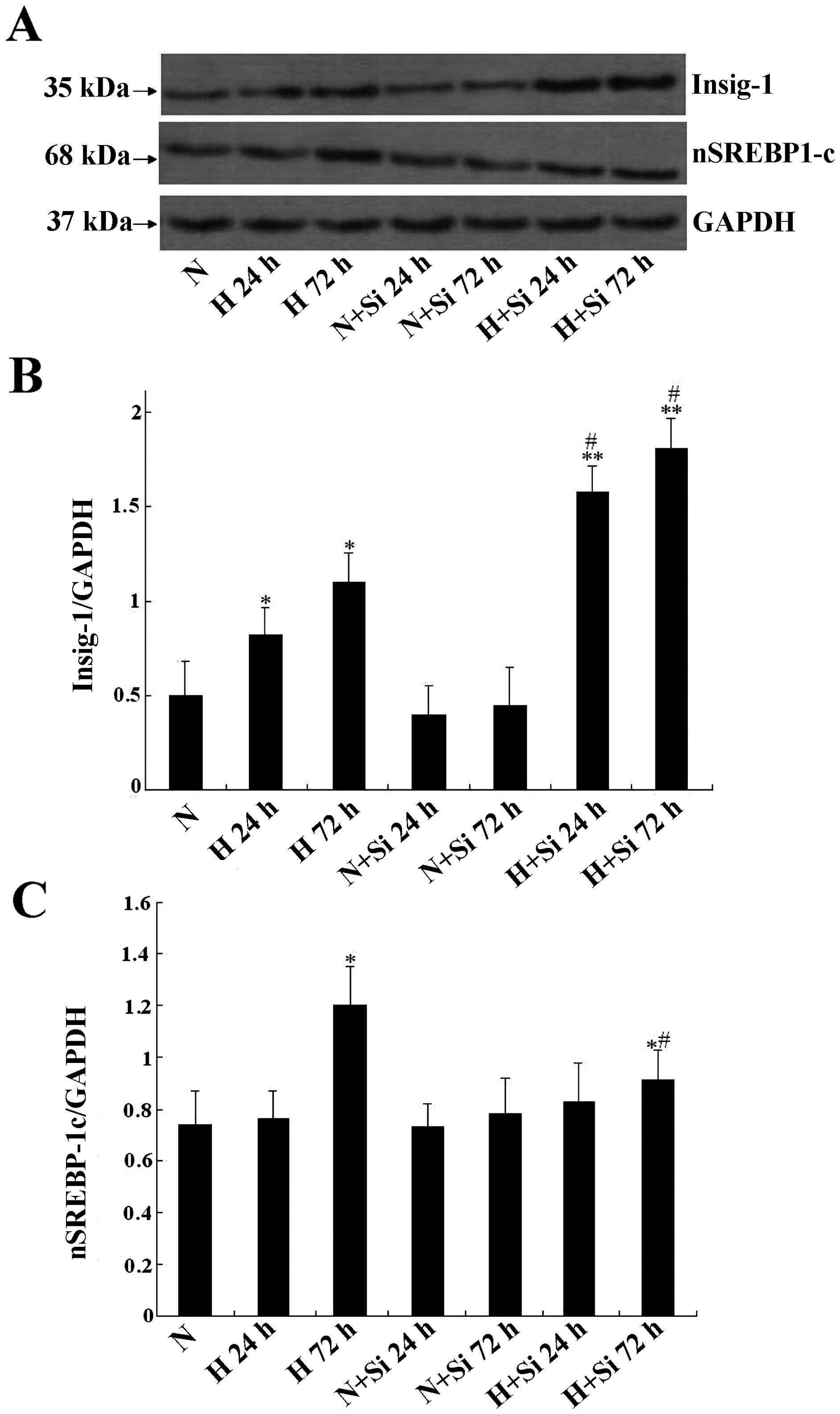Silibinin protects β cells from glucotoxicity through regulation of the Insig-1/SREBP-1c pathway
- Authors:
- Published online on: August 8, 2014 https://doi.org/10.3892/ijmm.2014.1883
- Pages: 1073-1080
Abstract
Introduction
Pancreatic β cell dysfunction, mainly caused by glucotoxicity, is an important factor leading to type 2 diabetes (1,2). High glucose-induced free fatty acid (FFA) synthesis leads to β cell apoptosis (3), impaired glucose-stimulated insulin secretion (GSIS) (4) and lipid accumulation (5). In recent years, sterol regulatory element binding protein-1c (SREBP-1c), an important lipogenic transcription factor (6), has been found to regulate genes involving insulin secretion (7).
Insulin induced gene-1 (Insig-1) is a critical upstream regulatory factor of SREBP-1c. Insig-1 prevents the SREBP cleavage-activating protein (SCAP)/SREBP-1c complex to translocate from the Golgi apparatus to the endoplasmic reticulum (ER), subsequently decreases nuclear SREBP-1c (nSREBP-1c) expression, and blocks the related gene transcription of SREBP-1c. It has been demonstrated that the upregulation of Insig-1 decreases SREBP-1c expression, thereby inhibiting lipid synthesis (8). In our previous study, we demonstrated that the overexpression of Insig-1 leads to the inhibition of SREBP-1c expression and the subsequent improvement of β cell function (9).
Silibinin is a flavonoid extracted from milk thistle (Silybum marianum), which has been used in the treatment of liver disorders for over 2,000 years. Recently, silibinin has been found to have antioxidant, anti-apoptotic and anti-inflammatory properties, to have interactions with steroid hormone receptors, and to be involved in the modulation of drug transporters. It has also been shown that silibinin is able to improve β cell function (10).
A number of in vivo and in vitro studies have demonstrated the protective effects of silibinin on β cell function. A clinical study demonstrated that silibinin reduced the levels of fasting blood glucose, glycosylated hemoglobin, cholesterol, triglycerides and low-density lipoprotein in patients with type 2 diabetes (11). In addition, silibinin decreases blood glucose levels in rats with type 1 diabetes induced by streptozotocin (STZ); however, no difference was observed in basal insulin secretion (12). Soto et al found that silibinin improved the symptoms in alloxan-induced diabetic rats through anti-oxidative stress and increased insulin secretion through the upregulation of insulin and pancreatic and duodenal homeobox 1 (PDX-1) mRNA expression (13). Silibinin has been shown to suppress interleukin (IL)-1β and interferon (IFN)-γ-induced nitric oxide (NO) production and ameliorate β cell dysfunction through the suppression of c-Jun NH2-terminal kinase (JNK)/signal transducer and activator of transcription (STAT) pathways (14). Silibinin has also been shown to protect β cell damage induced by cyclosporine A and regulate the physiological level of autophagy by promoting sirtuin (Sirt)-1 expression (15,16).
A previous study revealed that silibinin upregulates the expression of Insig-1 in mouse 3T3-L1 pre-adipocytes (17). In this study, we further explored the downstream effects of silibinin on the Insig-1/SREBP-1c pathway, which may be a novel target in the protection of β cells against glucotoxicity. The results clearly suggest that silibinin protects β cells from glucotoxicity through the regulation of the Insig-1/SREBP pathway.
Materials and methods
Materials
Silibinin was obtained from Sigma-Aldrich Shanghai Trading Co., Ltd. (Shanghai, China); β-mercaptoethanol, HEPES, L-glutamine and sodium pyruvate were purchased from Amresco, Inc. (Cleveland, OH, USA). The (3-(4,5-dimethylthiazol-2-yl)-2,5-diphenyltetrazolium bromide (MTT) assay kit, Hoechst 33258, Annexin V-propidium iodide (PI) apoptosis kit, total protein and nuclear protein extraction kits, enhanced chemiluminescence detection (ECL) kit, and the bicinchoninic acid (BCA) assay kit were all obtained from Beyotime Institute of Biotechnology (Haimen, China). The rat insulin ELISA kit was purchased from Linco Research, Inc. (St. Charles, MO, USA). TRIzol reagent and reverse transcription kit were from Life Technologies (Carlsbad, CA, USA). The SYBR®-Green PCR assay kit was purchased from Toyobo Co., Ltd., (Osaka, Japan). The polyvinylidene fluoride membrane was obtained from Millipore Corp. (Bedford, MA, USA). The primary antibodies to Insig-1, SREBP-1 and GAPDH and the secondary antibodies were all purchased from Santa Cruz Biotechnology, Inc. (Dallas, TX, USA). Lipofectamine 2000 was purchased from Invitrogen (Carlsbad, CA, USA). Oil Red O was purchased from Beijing Solarbio Science and Technology Co., Ltd., (Beijing, China), and the FFA ELISA kit was from USCN Life Science Inc. (Wuhan, China).
Cell culture
Rat insulinoma INS-1 cells were purchased from Bioleaf Biotech Co., Ltd. (Shanghai, China). The INS-1 cells were cultured in RPMI-1640 containing 11 mM glucose with 10 mM HEPES, 10% fetal bovine serum, 2 mM L-glutamine, 1 mM sodium pyruvate, 50 μM β-mercaptoethanol, 100 IU/ml penicillin and 100 IU/ml streptomycin and incubated at 37°C in a 5% CO2 atmosphere.
Measurement of cell viability
The INS-1 cells were incubated with or without 30 μM silibinin in normal glucose (11.2 mM) or high glucose (25.0 mM) RPMI-1640 for 0, 24 or 72 h. Cell viability was measured using an MTT assay kit. Briefly, at different time points, 10 μl of MTT (5 mg/ml) were added to the culture medium in a 96-well plate and incubated at 37°C for 4 h before 100 μl of formanzan was added to dissolve the MTT. After 3 h, the absorbance was measured at 570 nm.
Apoptosis assay by flow cytometry
After the INS-1 cells were incubated with or without 30 μM silibinin in normal glucose (11.2 mM) or high glucose (25.0 mM) RPMI-1640 for 0, 24 or 72 h, the cells were collected, washed with phosphate-buffered saline (PBS), resuspended in 200 μl of binding buffer containing 5 μl of Annexin V, and incubated in the dark for 10 min according to the manufacturer’s instructions. The cells were then stained with 10 μl of PI, and the samples were immediately analyzed using a flow cytometer (Epics XL; Beckman Coulter, Brea, CA, USA).
Assessment of cell apoptosis by Hoechst 33258 staining
For the Hoechst 33258 staining assay, the cells were washed twice with PBS, fixed with 4% paraformaldehyde for 30 min, and then washed 3 times with PBS. Hoechst 33258 (10 μg/ml) was added, and the cells were incubated in the dark at room temperature for 30 min before being washed with PBS. The nuclear morphology was observed under a fluorescence microscope (Olympus IX71; Olympus, Tokyo, Japan). The cells with condensed chromatin and shrunken nuclei were classified as apoptotic. One hundred nuclei from the control (untreated cells) and each group were counted, and the percentage of cleaved nuclei was calculated.
GSIS
The INS-1 cells (2×105) were seeded in 24-well cell culture plates containing RPMI-1640 medium with a normal or high glucose concentration for different periods of time. The cells were then washed twice with PBS and incubated in a 3 mM glucose KRBB solution (114 mM NaCl, 4.4 mM KCl, 1.28 mM CaCl2, 1 mM MgSO4, 29.5 mM NaHCO3, 10 mM HEPES,3 mM glucose, and 0.1% bovine serum albumin, pH 7.4) at 37°C for 1 h. After the supernatant was collected, 20 mM glucose KRBB were added to each well, the cells were incubated at 37°C for 1 h, and the supernatant was collected. The insulin levels in the supernatant were measured using a rat insulin ELISA kit.
Reverse transcription quantitative PCR
Total RNA was extracted using TRIzol reagent. Subsequently, 1 μg of total RNA was used for the synthesis of cDNA using a reverse transcription kit according to the manufacturer’s instructions. The SYBR-Green PCR assay (20 μl total volume) contained 10 μl of QuantiTect SYBR-Green PCR Master mix, 2 μl of cDNA, 1.2 μl of primer (10 μM) and 6.8 μl of RNase-free water. The primer sequences including insulin receptor substrate-2 (IRS-2), PDX-1 and uncoupling protein-2 (UCP-2) and PCR conditions were the same as those used in our previous study (9). The PCR was performed on a Mastercycler® ep realplex real-time PCR (Eppendorf, Hamburg, Germany). Relative differences in gene expression between groups were determined using the 2−ΔΔCT method.
Western blot analysis
The total protein and nuclear protein was extracted from the cells according to the manufacturer’s instructions. The protein concentration was determined using a BCA assay. Proteins (50 μg) were separated in 8–10% criterion precast gels and 5% polyacrylamide gels and transferred onto polyvinylidene fluoride membranes. After blocking for 1 h, the membranes were incubated with primary antibodies against Insig-1 (sc-51103, 1:200), SREBP-1 (sc-8984,1:300), or GAPDH (sc-47724,1:800) overnight at 4°C, followed by incubation with horseradish peroxidase (HRP)-conjugated secondary antibodies. GAPDH served as a loading control on the same membrane. Peroxidase activity was visualized using the ECL kit. The membranes were scanned and analyzed using Scion Image software (Scion Corp., Frederick, MD, USA).
Oil Red O staining and measurement of FFA content
The cells were washed twice in PBS and fixed with 4% paraformaldehyde for 30 min, and subsequently stained with fresh Oil Red O solution (60% Oil Red O stock solution consisting of 0.5% Oil Red O in isopropanol and 40% H2O) for 15 min. After staining, the lipid droplets were observed and photographed under a microscope (TE2000-E; Nikon, Tokyo, Japan). The cell culture supernatant was collected, and the FFA concentration was measured using an ELISA kit according to the manufacturer’s instructions.
Statistical analysis
The results are all presented as the means ± standard error (SE). Statistically significant differences between two groups was determined using the Student’s t-test. Groups of 3 or more were analyzed by one-way analysis of variance. Differences were considered to be statistically significant at P<0.05.
Results
Silibinin protects against high glucose-induced apoptosis in INS-1 cells
First, to define the suitable intervention concentration, we examined the apoptotic rate by Annexin V and PI double staining. The INS-1 cells were cultured in high glucose (25.0 mM) medium for 72 h with various concentrations of silibinin (0–80 μM). It was found that 10–20 μM of silibinin did not affect the apoptotic rate (P>0.05); however, 30–80 μM silibinin significantly decreased the apoptotic rate (P<0.05). A further increase in the silibinin concentration did not exert a greater inhibitory effect (P>0.05). In addition, Oil Red O staining revealed that 0 and 10 μM silibinin did not inhibit intracellular lipid accumulation, while 20–80 μM silibinin significantly decreased lipid accumulation (data not shown). Therefore, we selected 30 μM silibinin for the following experiments (Fig. 1A).
We then examined the apoptotic rate of the INS-1 cells using both Annexin V/PI double staining and Hoechst 33258 staining. Treatment of the cells with high glucose or high glucose and silibinin for 72 h resulted in the apoptosis of the INS-1 cells, as determined by flow cytometry. However, the number of apoptotic cells were significantly reduced in the high glucose and silibinin group compared to the high glucose group (P<0.05) (Fig. 1B). Hoechst 33258 staining revealed that the apoptotic cells had condensed nuclei and DNA fragmentation, and silibinin decreased the percentage of apoptotic cells at both the 24 and 72 h intervals compared to the high glucose group (P<0.05) (data from normal glucose without silibinin for 24 and 72 h are not shown; Fig. 1C).
Silibinin improves INS-1 cell viability under high glucose conditions
We used an MTT assay to determine whether silibinin protects the cells from the high glucose-induced decrease in cell viability. In the cells cultured in medium containing high glucose (25.0 mM), significant cell death was observed after 72 h; however, this was attenuated in the presence of 30 μM silibinin (P<0.05). The cells incubated in culture medium containing a normal glucose concentration (11.2 mM) did not show any obvious decrease in cell viability (P>0.05) (Fig. 2).
Silibinin improves insulin secretion under high glucose conditions
The insulin secretion of the INS-1 cells was measured following treatment with 3 or 20 mM glucose. No significant difference in insulin secretion was observed following treatment with 3 mM glucose (P>0.05). However, following treatment with 20 mM glucose, the INS-1 cells cultured in high glucose medium showed a significantly decreased insulin secretion (24 h, P<0.05; 72 h, P<0.01). Furthermore, treatment with silibinin partially restored the insulin secretion of the INS-1 cells cultured under high glucose conditions for both the 24- and 72-h periods (P<0.05) (Fig. 3).
Silibinin regulates the mRNA expression of Insig-1/SREBP-1c and insulin secretion-related genes
Subsequently, we examined the expression of genes related to the Insig-1/SREBP-1c signaling pathway and insulin secretion. The INS-1 cells were incubated in medium containing normal or high glucose concentrations for 72 h with or without silibinin. The mRNA expression of Insig-1, SREBP-1c and fatty acid synthetase (FAS) was significantly increased following exposure to high glucose for 72 h (P<0.05, <0.05 and <0.01, respectively) (Fig. 4A–C). Silibinin further upregulated Insig-1 mRNA expression but downregulated SREBP-1c (P<0.05) and FAS mRNA expression (P<0.01). Similar results were observed for the expression of insulin-related genes. High glucose induced the downregulation of IRS-2, PDX-1 and insulin genes and the upregulation of UCP-2 (P<0.01 for all). Silibinin reversed the effects caused by high glucose, markedly upregulating IRS-2, PDX-1 and insulin mRNA expression and downregulating UCP-2 mRNA expression under high glucose conditions (P<0.05 for all). By contrast, no difference in the mRNA expression of these genes was observed when the INS-1 cells were incubated under normal glucose conditions for 72 h (Fig. 4D–G).
Silibinin inhibits lipid droplet accumulation and FFA synthesis
To further explore whether silibinin inhibits lipid synthesis induced by high glucose, we used Oil Red O staining to detect intracellular lipid accumulation and the FFA concentration in the culture medium. The lipid droplets were stained bright red, and silibinin did not affect lipid accumulation under normal glucose conditions for 24 or 72 h (P>0.05). However, silibinin significantly reduced lipid accumulation induced by culture under high glucose conditions for both 24 and 72 h (P<0.05) (data of normal glucose without silibinin for 24 and 72 h are not shown; Fig. 5A). Similar results were observed for the FFA concentration; silibinin decreased FFA synthesis compared to cells cultured under high glucose conditions for 24 and 72 h (P<0.01) (Fig. 5B).
Silibinin regulation of the Insig-1/SREBP-1c pathway in INS-1 cells
To explore the mechanisms through which silibinin protects the INS-1 cells from glucotoxicity, we examined the protein expression of Insig-1 and SREBP1-c in the INS-1 cells cultured under different glucose concentrations. It was found that high glucose induced Insig-1 upregulation at 24 and 72 h (P<0.05), and silibinin further upregulated Insig-1 expression, in line with the mRNA expression profile (P<0.05) (Fig. 6A and B). The expression of SREBP-1c was significantly upregulated after the cells were treated with high glucose or high glucose plus silibinin for 72 h compared to the normal glucose group; however, in the high glucose plus silibinin group, the expression was lower than that in the high glucose group at 72 h. In addition, there was no significant difference between the other groups and the normal glucose group (Fig. 6C).
Discussion
In previous studies, some compounds have been confirmed to upregulate Insig-1 expression, including the novel hypocholesterolemic agent, LY295427, and the PPARγ agonist, rosiglitazone, which both bind the Insig-1 promoter and upregulate Insig-1 expression, thereby reducing lipogenesis in the liver and white adipose tissue (18,19). Sirolimus inhibits endogenous cholesterol synthesis through the upregulation of Insig-1, Insig-2 and SREBP-1 expression in human vascular smooth muscle cells (20). Recently, Ka et al (17) observed that silibinin upregulated Insig-1 and Insig-2 expression at an early phase during differentiation of 3T3-L1 preadipocytes to adipocytes. In their study, 30 μM silibinin almost completely inhibited lipid synthesis as well as certain important lipid metabolism factors, including SREBP-1c, FAS, and the adipocyte-specific lipid binding protein (aP2). These results indicated that silibinin may function through the upregulation of Insig-1 and Insig-2 expression, thereby inhibiting SREBP-1c transcription and finally leading to a decrease in lipid synthesis (17). In addition, Ka et al found that increasing the silibinin concentration did not result in increased apoptosis in 3T3-L1 cells. We also found that 10–100 μM silibinin did not induce the apoptosis of INS-1 cells (data not shown). Thus, it is likely that silibinin has a low toxicity. Furthermore, Nassuato et al reported that silibinin inhibited 3-hydroxymethyl-3-methylglutaryl coenzyme A (HMG-CoA) reductase, a key enzyme of cholesterol synthesis and an important downstream factor of the Insig-1/SREBP pathway, in a dose-dependent manner (21).
In our previous study, we demonstrated that the overexpression of Insig-1 protects β cell function against glucotoxicity, including a decrease in lipid synthesis, an increase in insulin secretion and a decrease in apoptosis (9). In this study, we further explored whether silibinin upregulates the Insig-1/SREBP-1c pathway to protect β cells against glucotoxicity. Several mechanisms of high glucose-induced apoptosis in β cells have been implicated, including ceramide formation (22,23), oxidative stress (24,25), inflammation (26) and ER stress (27–29). In this study, silibinin significantly improved cell viability and decreased cell apoptosis under high glucose conditions. Our previous study suggested that the overexpression of Insig-1 protects β cells through the regulation of the IRE1α pathway of ER-stress (9), possibly the same pathway through which silibinin protects β cell function, as demonstrated in the current study.
A clinical in vivo study revealed that silibinin promotes insulin secretion and reduces blood glucose levels (11). Similarly, our results also indicated that silibinin partially improved insulin secretion under high glucose conditions without affecting the basal insulin secretion observed under normal glucose conditions. Subsequently, we further explored the molecular mechanisms of promoting insulin secretion in β cells. SREBP-1c is an important nuclear transcription factor and plays a key role in the regulation of insulin secretion; both in vivo and in vitro studies have demonstrated that the overexpression of SREBP-1c impairs insulin secretion (30). SREBP-1c suppresses IRS-2 activity through direct binding to the IRS-2 promoter, which may contribute to the GSIS of β cells (31). PDX-1 is a crucial transcription factor in the regulation of insulin secretion. In addition, the overexpression of SREBP-1c suppresses PDX-1 expression both in vivo and in vitro. However, PDX-1 is upregulated when SREBP-1c is knocked down in islet cells (32); UCP-2 may be a negative regulator of cytoplasmic adenosine triphosphate (ATP)/adenosine diphosphate (ADP), which is a key signaling molecule in GSIS. SREBP-1c stimulates UCP-2 expression in β cells under a high nutrition state (33). In our study, Insig-1 expression was upregulated following culture under high glucose conditions for 72 h. By contrast, SREBP-1c expression was downregulated, and the insulin secretion-related genes, IRS-2, PDX-1 and insulin, were upregulated but UCP-2 was downregulated. Thus, silibinin may upregulate Insig-1, subsequently suppressing SREBP-1c expression, further inhibiting the transcription of insulin secretion-related genes.
Sandberg et al demonstrated that high glucose-induced lipogenesis in β cells is regulated by SREBP-1 (34). Li et al found that both Insig-1 and SREBP-1c were upregulated during the differentiation of 3T3-L1 cells (35). In this study, we also proved that Insig-1 and SREBP-1c were upregulated with lipid accumulation. However, silibinin significantly decreased intracellular lipid accumulation and FFA synthesis. We further explored the protein expression following treatment with silibinin. Silibinin upregulated the Insig-1 protein level after the cells were exposed to high glucose conditions for 24 and 72 h. However, the SREBP-1c protein level was only downregulated at 72 h. Further studies are required to fully elucidate the mechanisms through which silibinin upregulated Insig-1 expression.
In conclusion, we found that silibinin ameliorated β cell dysfunction through the regulation of the Insig-1/SREBP-1c pathway, including blocking β cell apoptosis and increasing cell viability, improving insulin secretion and inhibiting lipid synthesis. Investigation of the molecular mechanisms revealed that silibinin may upregulate Insig-1 expression and downregulate SREBP-1c transcription, both of which regulate the expression of downstream insulin secretion-related genes and lipid synthesis, further increasing insulin secretion and decreasing lipid production. Thus, silibinin may be a novel therapeutic agent for β cell dysfunction.
Acknowledgements
The present study was supported by grants from the National Nature Science Foundation of China (no. 81200599) and Hunan Province Nature Science Foundation of China (nos. 13JJ4027 and 06JJ5035). We thank Medjaden Bioscience Ltd. for assisting in the preparation of this manuscript.
References
|
Imamura F, Mukamal KJ, Meigs JB, et al: Risk factors for type 2 diabetes mellitus preceded by β-cell dysfunction, insulin resistance, or both in older adults: the Cardiovascular Health Study. Am J Epidemiol. 177:1418–1429. 2013. | |
|
Bensellam M, Laybutt DR and Jonas JC: The molecular mechanisms of pancreatic β-cell glucotoxicity: Recent findings and future research directions. Mol Cell Endocrinol. 364(1–2): 1–27. 2012. | |
|
Kwon MJ, Chung HS, Yoon CS, et al: Low glibenclamide concentrations affect endoplasmic reticulum stress in INS-1 cells under glucotoxic or glucolipotoxic conditions. Korean J Intern Med. 28:339–346. 2013. View Article : Google Scholar | |
|
Somesh BP, Verma MK, Sadasivuni MK, et al: Chronic glucolipotoxic conditions in pancreatic islets impair insulin secretion due to dysregulated calciumdynamics, glucose responsiveness and mitochondrial activity. BMC Cell Biol. 14:312013. View Article : Google Scholar | |
|
Filhoulaud G, Guilmeau S, Dentin R, et al: Novel insights into ChREBP regulation and function. Trends Endocrinol Metab. 24:257–268. 2013. View Article : Google Scholar : PubMed/NCBI | |
|
Jeon TI and Osborne TF: SREBPs: metabolic integrators in physiology and metabolism. Trends Endocrinol Metab. 23:65–72. 2012. View Article : Google Scholar : PubMed/NCBI | |
|
Sandberg MB, Fridriksson J, Madsen L, et al: Glucose-induced lipogenesis in pancreatic beta cells is dependent on SREBP-1. Mol Cell Endocrinol. 240:94–106. 2005. View Article : Google Scholar : PubMed/NCBI | |
|
Dong XY and Tang SQ: Insulin-induced gene: a new regulator in lipid metabolism. Peptides. 31:2145–2150. 2012. View Article : Google Scholar : PubMed/NCBI | |
|
Chen K, Jin P, He HH, et al: Overexpression of Insig-1 protects β cell against glucolipotoxicity via SREBP-1c. J Biomed Sci. 18:572011. | |
|
Gazák R, Walterová D and Kren V: Silybin and silymarin-new and emerging applications in medicine. Curr Med Chem. 14:315–338. 2007.PubMed/NCBI | |
|
Huseini HF, Larijani B, Heshmat R, et al: The efficacy of Silybum marianum (L.) Gaertn. (silymarin) in the treatment of type II diabetes: a randomized, double-blind, placebo-controlled, clinical trial. Phytother Res. 20:1036–1039. 2006. | |
|
Maghrani M, Zeggwagh NA, Lemhadri A, et al: Study of the hypoglycaemic activity of Fraxinus excelsior and Silybum marianum in an animal model of type 1 diabetes mellitus. J Ethnopharmacol. 91:309–316. 2004. | |
|
Soto CP, Perez BL, Favari LP and Reyes JL: Prevention of alloxan-induced diabetes mellitus in the rat by silymarin. Comp Biochem Physiol C Pharmacol Toxicol Endocrinol. 119:125–129. 1998. View Article : Google Scholar : PubMed/NCBI | |
|
Matsuda T, Ferreri K, Todorov I, et al: Silymarin protects pancreatic beta-cells against cytokine-mediated toxicity: implication of c-Jun NH2-terminal kinase and janus kinase/signal transducer and activator of transcription pathways. Endocrinology. 146:175–185. 2005. View Article : Google Scholar | |
|
Von Schönfeld J, Weisbrod B and Müller MK: Silibinin, a plant extract with antioxidant and membrane stabilizing properties, protects exocrine pancreas from cyclosporin A toxicity. Cell Mol Life Sci. 53:917–920. 1997.PubMed/NCBI | |
|
Wang Q, Liu M, Liu WW, et al: In vivo recovery effect of silibinin treatment on streptozotocin-induced diabetic mice is associated with the modulations of Sirt-1 expression and autophagy in pancreatic β-cell. J Asian Nat Prod Res. 14:413–423. 2012.PubMed/NCBI | |
|
Ka SO, Kim KA, Kwon KB, Park JW and Park BH: Silibinin attenuates adipogenesis in 3T3-L1 preadipocytes through a potential upregulation of the insig pathway. Int J Mol Med. 23:633–637. 2009.PubMed/NCBI | |
|
Janowski BA: The hypocholesterolemic agent LY295427 up-regulates INSIG-1, identifying the INSIG-1 protein as a mediator of cholesterol homeostasis through SREBP. Proc Natl Acad Sci USA. 99:12675–1280. 2002. View Article : Google Scholar : PubMed/NCBI | |
|
Kast-Woelbern HR, Dana SL, Cesario RM, et al: Rosiglitazone induction of Insig-1 in white adipose tissue reveals a novel interplay of peroxisome proliferator-activated receptor gamma and sterol regulatory element-binding protein in the regulation of adipogenesis. J Biol Chem. 279:23908–23915. 2004. View Article : Google Scholar | |
|
Ma KL, Varghese Z, Ku Y, et al: Sirolimus inhibits endogenous cholesterol synthesis induced by inflammatory stress in human vascular smooth muscle cells. Am J Physiol Heart Circ Physiol. 298:H1646–H1651. 2010. View Article : Google Scholar | |
|
Nassuato G, Iemmolo RM, Strazzabosco M, et al: Effect of Silibinin on biliary lipid composition. Experimental and clinical study. J Hepatol. 12:290–295. 1991. View Article : Google Scholar : PubMed/NCBI | |
|
Lupi R, Dotta F, Marselli L, et al: Prolonged exposure to free fatty acids has cytostatic and pro-apoptotic effects on human pancreatic islets: evidence that beta-cell death is caspase mediated, partially dependent on ceramide pathway, and Bcl-2 regulated. Diabetes. 51:1437–1442. 2002. View Article : Google Scholar | |
|
Maedler K, Oberholzer J, Bucher P, et al: Monounsaturated fatty acids prevent the deleterious effects of palmitate and high glucose on human pancreatic beta-cell turnover and function. Diabetes. 52:726–733. 2003. View Article : Google Scholar : PubMed/NCBI | |
|
Morgan D, Oliveira-Emilio HR, Keane D, et al: Glucose, palmitate and pro-inflammatory cytokines modulate production and activity of a phagocyte-like NADPH oxidase in rat pancreatic islets and a clonal beta cell line. Diabetologia. 50:359–369. 2006. View Article : Google Scholar : PubMed/NCBI | |
|
Wang X, Li H, De Leo D, et al: Gene and protein kinase expression profiling of reactive oxygen species-associated lipotoxicity in the pancreatic beta-cell line MIN6. Diabetes. 53:129–140. 2004. View Article : Google Scholar : PubMed/NCBI | |
|
Busch AK, Cordery D, Denyer GS and Biden J: Expression profiling of palmitate-and oleate-regulated genes provides novel insights into the effects of chroniclipid exposure on pancreatic beta-cell function. Diabetes. 51:977–987. 2002. View Article : Google Scholar : PubMed/NCBI | |
|
Cunha DA, Hekerman P, Ladrière L, et al: Initiation and execution of lipotoxic ER stress in pancreatic beta-cells. J Cell Sci. 121:2308–2318. 2008. View Article : Google Scholar : PubMed/NCBI | |
|
Bachar E, Ariav Y, Ketzinel-Gilad M, et al: Glucose amplifies fatty acid-induced endoplasmic reticulum stress in pancreatic beta-cells via activation of mTORC1. Plos One. 4:e49542009. View Article : Google Scholar : PubMed/NCBI | |
|
Gwiazda KS, Yang TL, Lin Y and Johnson JD: Effects of palmitate on ER and cytosolic Ca2+ homeostasis in beta-cells. Am J Physiol Endocrinol Metab. 296:E690–E701. 2009. View Article : Google Scholar : PubMed/NCBI | |
|
Shimano H, Amemiya-Kudo M, Takahashi A, et al: Sterol regulatory element-binding protein-1c and pancreatic beta-cell dysfunction. Diabetes Obes Metab. 9(Suppl 2): 133–139. 2007. View Article : Google Scholar : PubMed/NCBI | |
|
Eizirik DL, Cardozo AK and Cnop M: The role for endoplasmic reticulum stress in diabetes mellitus. Endocr Rev. 29:42–61. 2008. View Article : Google Scholar : PubMed/NCBI | |
|
Amemiya-Kudo M, Oka J, Takeuchi Y, et al: Suppression of the pancreatic duodenal homeodomain transcription factor-1 (Pdx-1) promoter by sterol regulatory element-binding protein-1c (SREBP-1c). J Biol Chem. 286:27902–27914. 2011. View Article : Google Scholar | |
|
Medvedev AV, Robidoux J, Bai X, et al: Regulation of the uncoupling protein-2 gene in INS-1 beta-cells by oleic acid. J Biol Chem. 277:42639–42644. 2002.PubMed/NCBI | |
|
Sandberg MB, Bloksgaard M, Duran-Sandoval D, et al: The gene encoding acyl-CoA-binding protein is subject to metabolic regulation by both sterol regulatory element-binding protein and peroxisome proliferator-activated receptor alpha in hepatocytes. J Biol Chem. 280:5258–5266. 2005. View Article : Google Scholar | |
|
Li J, Takaishi K, Cook W, McCorkle SK and Unger RH: Insig-1 ‘brakes’ lipogenesis in adipocytes and inhibits differentiation of preadi-pocytes. Proc Natl Acad Sci USA. 100:9476–9481. 2003. |




